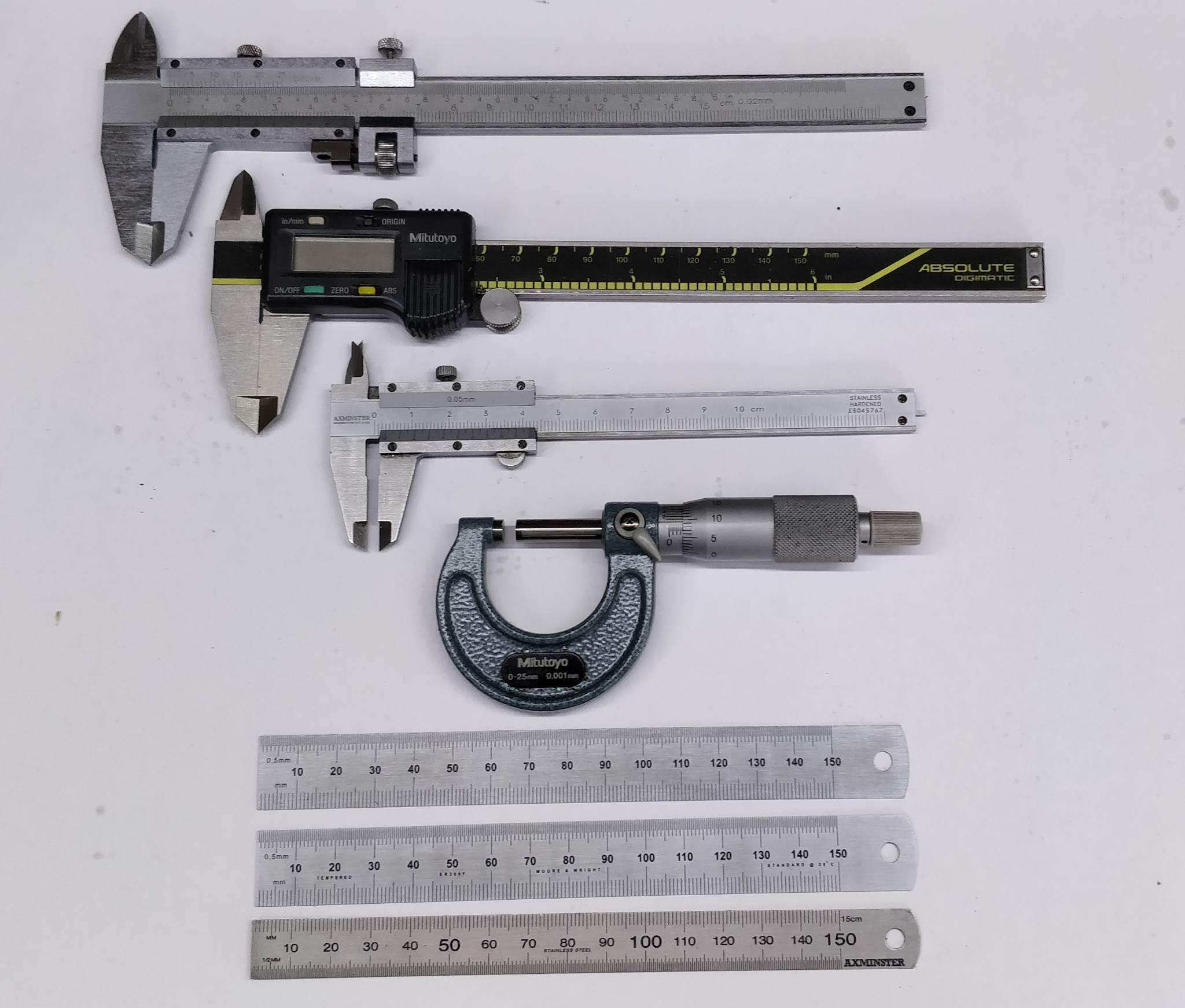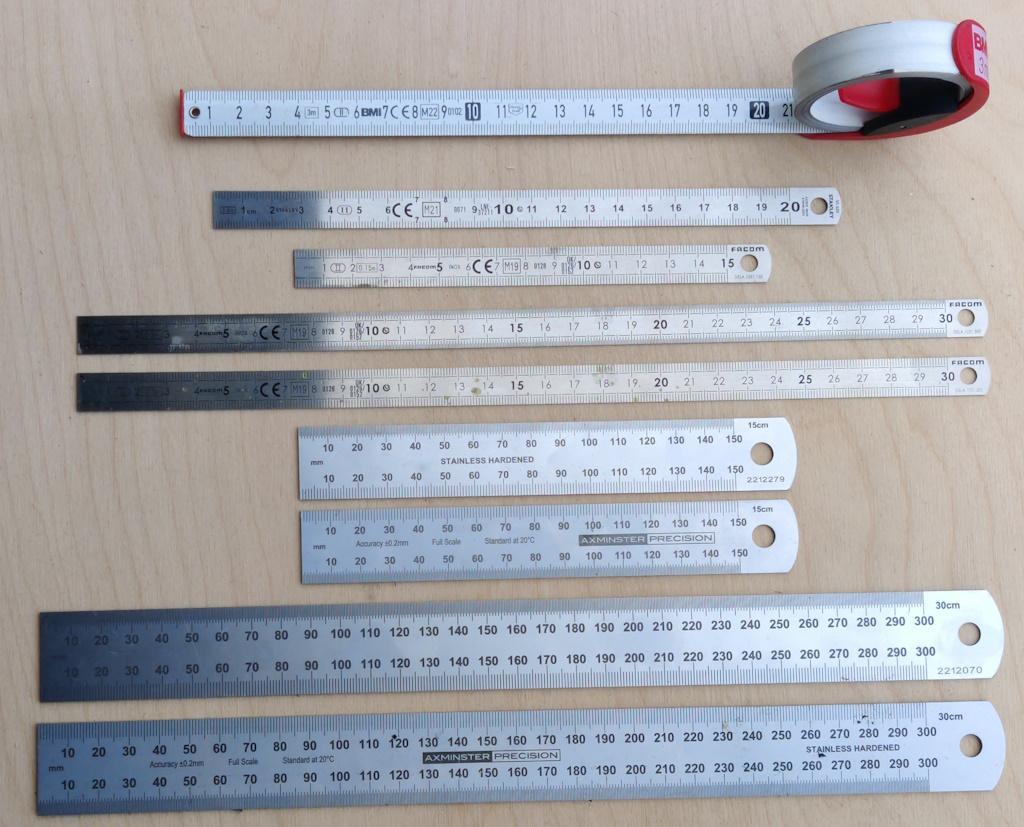Measuring Tools
I have a few different calipers in periodic use. The one I use 90% of the time is an Axminster 100 mm Pocket Vernier Caliper (third one down in the photo). This only reads to the nearest 0.05 mm (50 μm, but for most of my use this is ample and the small size of the caliper makes it very convenient. Where precision is required, the 1 μm reading Mitutoyo micrometer (with a vernier scale in addition to the normal micrometer scale - fourth one down in the photo) comes out of the drawer. Neither of these are digital and hence I never have to worry about batteries running out or zero-positions having drifted (give or take a very infrequent check just to be sure).
A few years ago I bought a cheap digital caliper (not shown in the picture above). These are available from a number of different suppliers, typically for less than £20. They use an incremental (i.e. keeping track of position continuously and losing position if the battery goes flat) capacitative scale. If you move them quickly when powered off (but with a battery) they have to track this movement, so they never properly shut down. As a result, the batteries don't tend to last long and with my relatively infrequent use I was finding that I needed to change the battery pretty much every time I used the caliper. As a result of all that, it didn't get used much.
I've since bought a second-hand Mitutoyo Absolute Digital Caliper (second in the photo above), which is much higher quality and has an absolute (rather than incremental) scale and hence doesn't suffer from these problems. This is shown in the picture above. Having said that, I still use the 100 mm vernier-scaled one more than the digital one, just the ratio is probably 60:40 now.
Also shown in the picture are a couple of Moore & Wright ER306F 150 mm steel rules and an old Axminster one. The two M&W steel rules are shown opposite ways up. I've searched for a long time for a genuinely useful metric-only steel rule. If someone at Moore & Wright had actually thought about the use of this ruler when they made it, they might have swapped the scales on each side. If you look closely at the image above (like all photos on this site, you can click on them for a better view), you'll see that on both sides of the steel rule, the bottom edge has 1 mm graduations and the top edge has 0.5 mm graduations. I really don't understand why they didn't swap these round on one of the sides. Even more frustratingly, the photo on the website from which I bought them shows them with swapped layouts exactly as I'd hoped they'd be.
On the Axminster one, rather than having a swapped layout on the rear, they put a conversion table between inches and millimetres. Please can someone at Axminster explain to me why they think I'd go to the effort of searching for a metric-only ruler but want an imperial conversion table on the back (which is way more difficult to use for imperial than just getting a metric/imperial ruler)?!
This photo shows a selection of better metric measurement tools that I've discovered more recently. The one at the top is an open-frame tape measure. This doesn't have a 0.5 mm scale, but the whole millimetre scale is the one I use most often and I use this tape measure all the time. It's compact and convenient so lives in my pocket whenever I'm in the workshop. Unfortunately, these are relatively difficult to buy in the UK (some websites that sell them only sell the metric/imperial version which I would not want to buy). For anyone else wanting one, they are made by BMI and the part numbers for the 2 metre and 3 metre versions are 429 24 1020 and 429 34 1020 (sometimes listed without the spaces in the numbers, sometimes ending in 1021 instead of 1020). If you're ordering one, make sure the middle number (24 or 34) ends with 4 and not 5.
I found mine on ebay, but the only consistent UK suppliers I've found are RS (expensive) and PowerTools Direct.
Also shown in the image are a selection of better steel rules. The best ones in terms of layout are the top four. The top one is made by Stanley and has part number 35-522. The other three are made by Facom and have part numbers DELA.1051.150 for the 150 mm version and DELA.1051.300 for the 300 mm version (a 200 mm version is also available). All of these have millimetres on both edges of one side and half-millimetres on both edges of the other side. This is how steel rules should be designed!
The four larger steel rules at the bottom of the photo are made by Axminster (I think they are the ones at this link). I like the size and thickness of them (they're 1 mm thick, unlike most steel rules that are 0.5 mm thick). Unlike the Facom Dela rules, one side has millimetres on the top edge and half-millimetres on the bottom edge and the other has half-millimetres on the top edge and millimetres on the bottom edge. This does at least mean that you can use your chosen scale on either edge. However, in most real uses, I decide what I want to measure (half-millimetres or millimetres) and then offer the rule up. With the Facom rules, I pick (say) the millimetre face, put it on the workpiece and then pick the edge that's most convenient. With the Axminster one, I put it on the workpiece and frequently have to turn it over to get the edge I want. That's much less convenient but it's still infinitely better than the Moore and Wright ones described above or any of the many metric/imperial options that are commonly available.
I believe Mitutoyo also make one that is similar to the Axminster one (i.e. not as good as the Facom design). The Mitutoyo one is sold as 182-111. If you come across any other manufacturers who make one with a sensible layout like the Facom ones, then please do get in touch and I'll add them to this page.
My old metric/imperial steel rules just get used as convenient 0.5 mm thick spacers these days, never as measuring devices!
This website is free and ad-free, but costs me money to run. If you'd like to support this site, please consider making a small donation or sending me a message to let me know what you liked or found useful.


